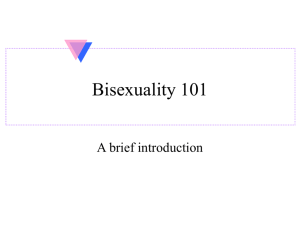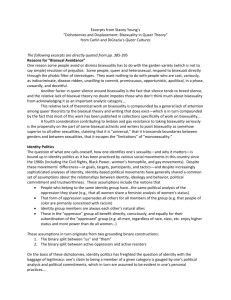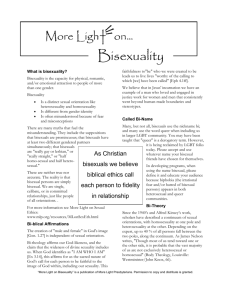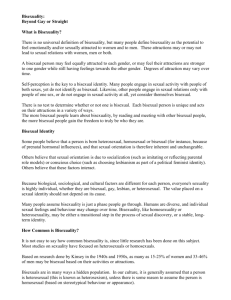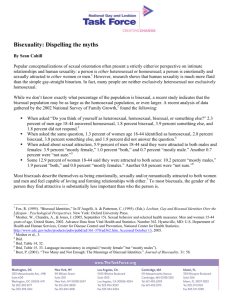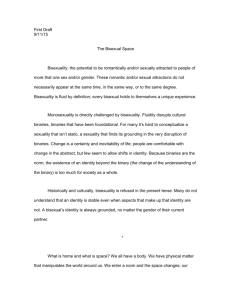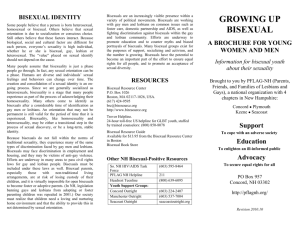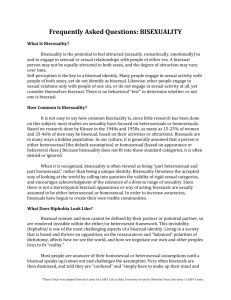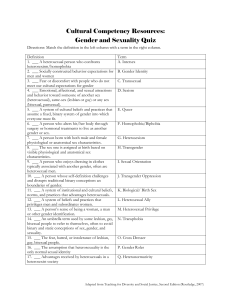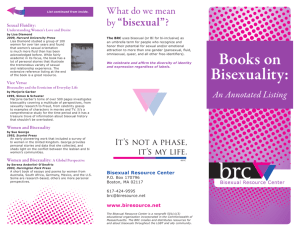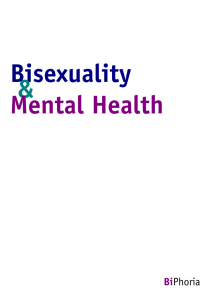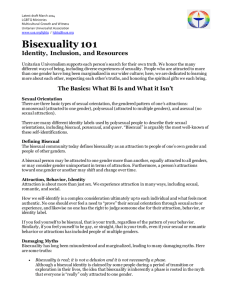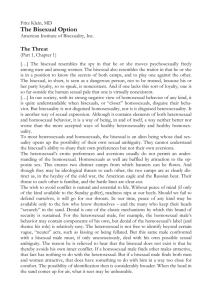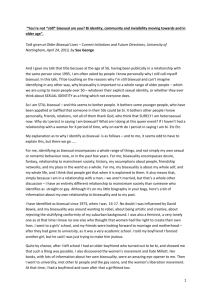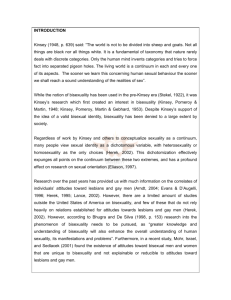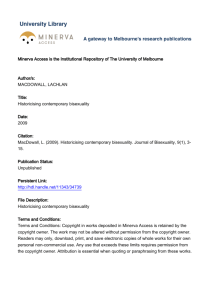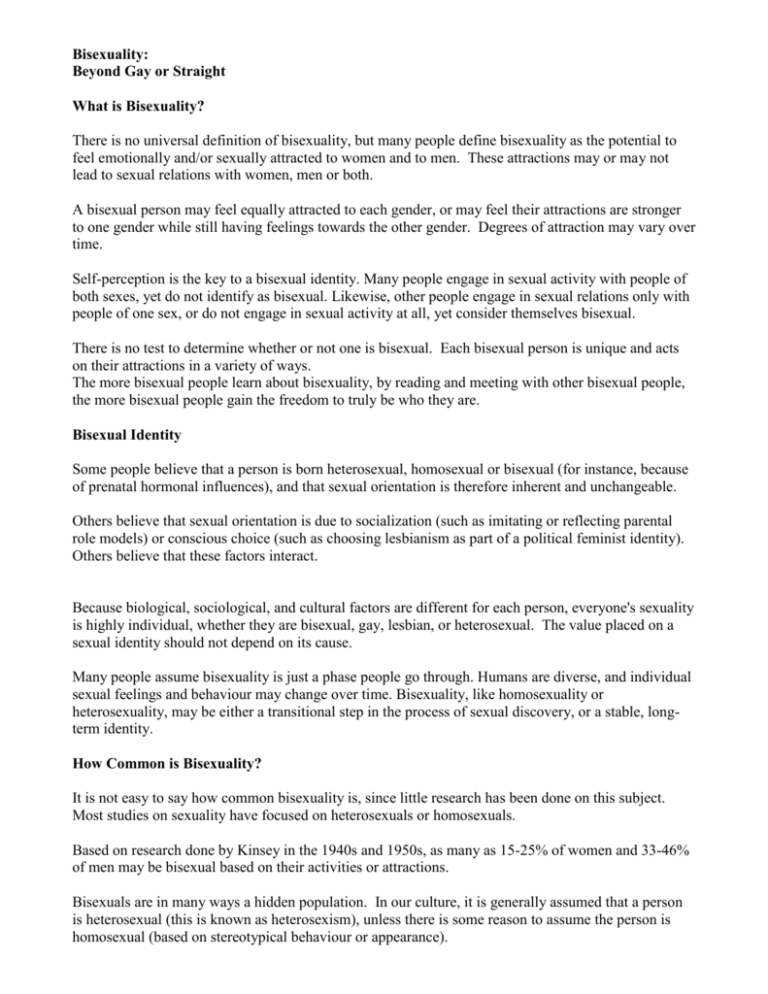
Bisexuality:
Beyond Gay or Straight
What is Bisexuality?
There is no universal definition of bisexuality, but many people define bisexuality as the potential to
feel emotionally and/or sexually attracted to women and to men. These attractions may or may not
lead to sexual relations with women, men or both.
A bisexual person may feel equally attracted to each gender, or may feel their attractions are stronger
to one gender while still having feelings towards the other gender. Degrees of attraction may vary over
time.
Self-perception is the key to a bisexual identity. Many people engage in sexual activity with people of
both sexes, yet do not identify as bisexual. Likewise, other people engage in sexual relations only with
people of one sex, or do not engage in sexual activity at all, yet consider themselves bisexual.
There is no test to determine whether or not one is bisexual. Each bisexual person is unique and acts
on their attractions in a variety of ways.
The more bisexual people learn about bisexuality, by reading and meeting with other bisexual people,
the more bisexual people gain the freedom to truly be who they are.
Bisexual Identity
Some people believe that a person is born heterosexual, homosexual or bisexual (for instance, because
of prenatal hormonal influences), and that sexual orientation is therefore inherent and unchangeable.
Others believe that sexual orientation is due to socialization (such as imitating or reflecting parental
role models) or conscious choice (such as choosing lesbianism as part of a political feminist identity).
Others believe that these factors interact.
Because biological, sociological, and cultural factors are different for each person, everyone's sexuality
is highly individual, whether they are bisexual, gay, lesbian, or heterosexual. The value placed on a
sexual identity should not depend on its cause.
Many people assume bisexuality is just a phase people go through. Humans are diverse, and individual
sexual feelings and behaviour may change over time. Bisexuality, like homosexuality or
heterosexuality, may be either a transitional step in the process of sexual discovery, or a stable, longterm identity.
How Common is Bisexuality?
It is not easy to say how common bisexuality is, since little research has been done on this subject.
Most studies on sexuality have focused on heterosexuals or homosexuals.
Based on research done by Kinsey in the 1940s and 1950s, as many as 15-25% of women and 33-46%
of men may be bisexual based on their activities or attractions.
Bisexuals are in many ways a hidden population. In our culture, it is generally assumed that a person
is heterosexual (this is known as heterosexism), unless there is some reason to assume the person is
homosexual (based on stereotypical behaviour or appearance).
Because bisexuality does not fit into these standard categories, it tends to be denied or ignored. When
it is recognized, bisexuality is often viewed as being „part heterosexual and part homosexual‰, rather
than being a unique identity.
Bisexuality threatens the accepted way of looking at the world by calling into question the validity of
rigid sexual categories, and encourages acknowledgment of the existence of a diverse range of
sexuality. Bisexuals are usually assumed to be either heterosexual or homosexual.
Many heterosexuals, gays and lesbians are friendly and supportive of bisexuals, yet some are not
(biphobia). Bisexuals face discrimination from homophobia and heterosexism and are also affected by
internalized homophobia in many of the same ways gays and lesbians are.
Bisexuals and AIDS
AIDS has had a major impact on the gay, lesbian and bisexual community. Bisexual men are often
scapegoated as the agents of transmission of AIDS from the gay to the heterosexual population, and
bisexual women may be scapegoated as transmitters of AIDS from men to lesbians.
However, it is behaviour, rather than sexual orientation, that puts people at risk for acquiring the virus
that causes AIDS. HIV is transmitted when infected blood, semen or vaginal fluid comes into contact
with your bloodstream.
Bisexuals, as well as homosexuals and heterosexuals, must educate themselves about safer sex
practices, such as the use of condoms and dental dams.
Safer sex guidelines can be obtained from health centres and AIDS education and service
organizations.
Myths about Bisexuality
BISEXUALS DON'T EXIST
Actually, there are over 1000 bisexual groups worldwide. Bisexuals are everywhere. Many bisexuals
say they are heterosexual, lesbian or gay because they fear others will not accept or understand their
bisexuality.
BISEXUALITY IS JUST A PHASE
Many people are attracted to both women and men and remain that way their entire lives. Some
bisexual people go through a period of calling themselves gay, lesbian, or heterosexual before calling
themselves bisexual. Likewise, some gay men and lesbians call themselves bisexual before identifying
as gay or lesbian.
BISEXUALS ARE CONFUSED
Sexuality can be confusing, but bisexuals are no more or less uncertain about their sexuality than
heterosexuals, lesbians or gays. Many of today's best known theories about how sexuality works have
been developed by bisexuals.
BISEXUALS ARE UNDEPENDABLE LOVERS, PARTNERS AND ACTIVISTS
Bisexuals have been actively involved in all aspects of struggles to end discrimination against lesbians,
gays, bisexuals, and transgendered people. Heterosexuals, lesbians and gays are no more or less
faithful in relationships than bisexual people.
Further Reading:
The Bisexual Option, 2nd ed. F. Klein, New York: Haworth Press, 1993.
Bisexual Politics: Theories, Queries and Visions, N. Tucker (ed.), Binghamton, N.Y. Haworth Press,
1995.
Bi Any Other Name: Bisexual People Speak Out, Hutchins & Ka‚ahumanu (ed.), Boston: Alyson Pub.
1991.
Bisexuality and the Challenge to Lesbian Politics, P.C. Rust, New York: New York University Press,
1995.
http://www.rainbowresourcecentre.org/resources.htm

